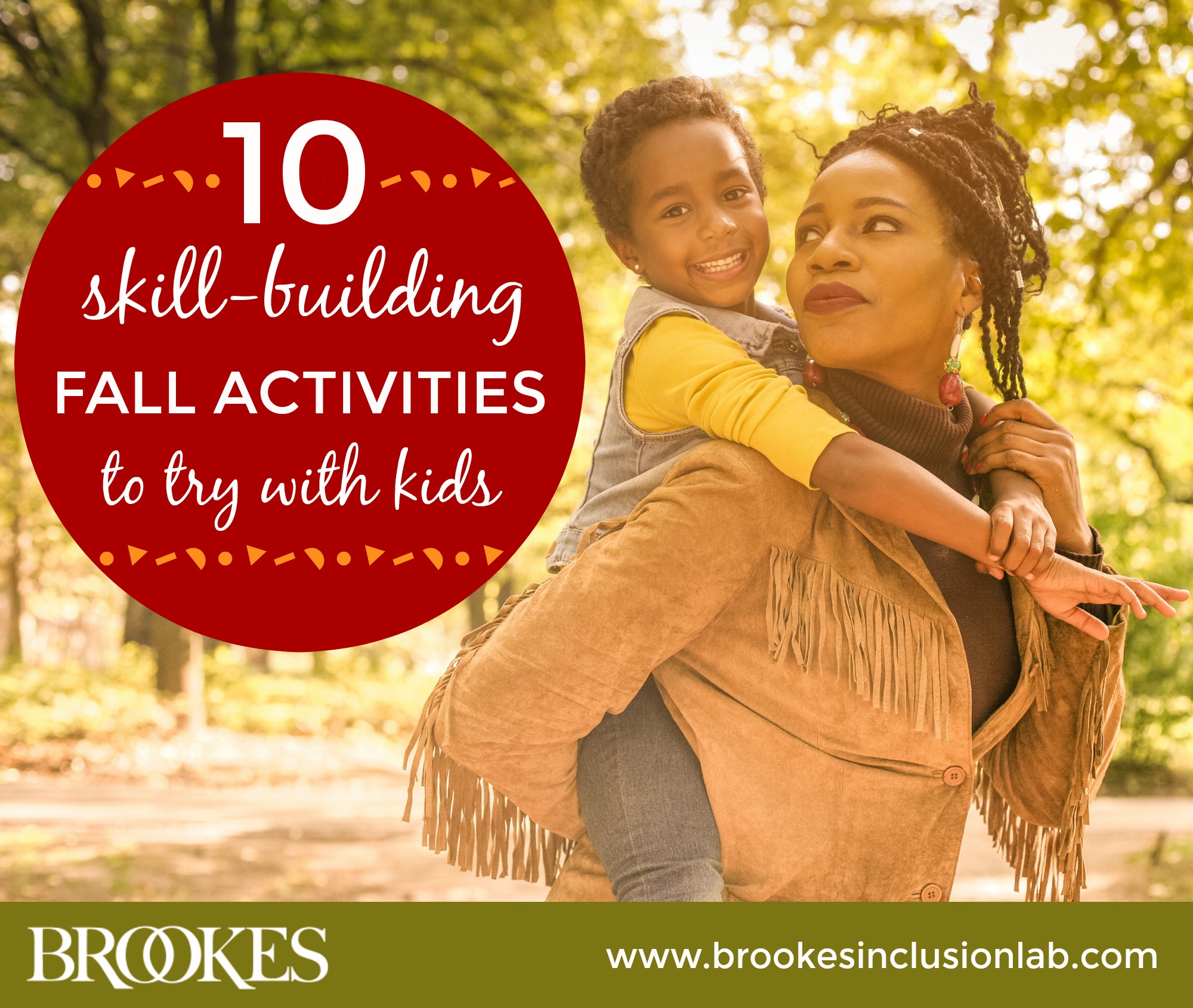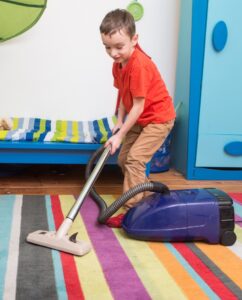10 Things Parents Can Do This Fall to Boost Their Child’s Development
September 29, 2020
[Edited and updated on September 14, 2023]
Many families look forward to the natural beauty and fun activities associated with the fall season. In today’s post, you’ll find 10 things that families can do with their young children this fall to bond with them and boost development at the same time. These suggestions were adapted from the ASQ-3 Learning Activities and the ASQ:SE-2 Learning Activities. Share this article with parents of young children, and help them create some great learning experiences with their children in the weeks to come!
 Have outdoor adventures every day you can. Outdoor activities are the perfect way to give your child’s motor skills a pick-me-up this fall. Choose activities that involve both gross motor skills (running, hopping, climbing, catching) and fine motor skills (grasping tools, digging, stacking). You might try making an outdoor adventure path or obstacle course for children to follow, or going on a neighborhood nature walk or scavenger hunt.
Have outdoor adventures every day you can. Outdoor activities are the perfect way to give your child’s motor skills a pick-me-up this fall. Choose activities that involve both gross motor skills (running, hopping, climbing, catching) and fine motor skills (grasping tools, digging, stacking). You might try making an outdoor adventure path or obstacle course for children to follow, or going on a neighborhood nature walk or scavenger hunt.
Bake pretzel letters together. As the sweltering summer gives way to cool fall breezes, baking edible letters with your child will fill your home with extra warmth and help them with motor, problem-solving, and early literacy skills. Wash your hands with your child first, and then cut pizza dough into strips (or make your own dough with a recipe like this one). Help your child form letters with the dough, and show them how to brush the letters with a beaten egg, sprinkle them with salt, and bake until golden brown. Review the sounds that each letter makes as you form the shapes. Eat up your ABCs together! (To help reinforce early math skills, you can also make pretzel numbers.)
 Go on a special date. For some social skills practice, go on an afternoon “date” with your child (for example, have a picnic at a local park). Before you head out, go through the steps of getting ready together. Have your child put on a special or favorite outfit, wash hands and face, use the bathroom, and brush teeth. Give your child a mirror so they can see how great they look. On your date together, be extra polite: say “please” and “thank you” and model taking turns and making requests.
Go on a special date. For some social skills practice, go on an afternoon “date” with your child (for example, have a picnic at a local park). Before you head out, go through the steps of getting ready together. Have your child put on a special or favorite outfit, wash hands and face, use the bathroom, and brush teeth. Give your child a mirror so they can see how great they look. On your date together, be extra polite: say “please” and “thank you” and model taking turns and making requests.
Create an autumn-themed sculpture or table centerpiece. Working as a team with your child, gather materials from outside (twigs and branches, acorns, pine cones, pretty stones) and around your home (newspaper, Popsicle sticks, small boxes, plastic containers, bits of ribbon, and fabric). For fine-motor practice, give your child masking tape, pipe cleaners, duct tape, and some glue for joining materials together. Put the materials in a place where your child can work on their special creation for a few days and let the sculpture dry. When it’s done, proudly display it on the table, your mantel, or another prominent location in your home.
 Give kids their own day jobs. Children enjoy having their own daytime jobs that make them feel important and needed, especially if their older siblings have gone back to school. To boost their confidence and help strengthen their social and motor skills, select age-appropriate jobs for them. Toddlers can take on table-wiping duty and help you sweep up the floor, while older children can prepare their own snack, fold laundry, and set the table for dinner. Children who look up to older siblings and parents might also like to have a pretend office in a corner of your home where they can write letters, have their own “meetings” with a toy phone or laptop, and type important emails with an old keyboard.
Give kids their own day jobs. Children enjoy having their own daytime jobs that make them feel important and needed, especially if their older siblings have gone back to school. To boost their confidence and help strengthen their social and motor skills, select age-appropriate jobs for them. Toddlers can take on table-wiping duty and help you sweep up the floor, while older children can prepare their own snack, fold laundry, and set the table for dinner. Children who look up to older siblings and parents might also like to have a pretend office in a corner of your home where they can write letters, have their own “meetings” with a toy phone or laptop, and type important emails with an old keyboard.
Have outside fun with fall leaves. To sharpen fine and gross motor skills, see how many fun activities you can do with the leaves in your backyard or around your building. Head outside with your child to rake leaves together, and jump in or leap over the piles. See how many leaves you can catch as they fall. Collect and sort leaves of different colors, sizes, and shapes. (If you’re feeling extra creative, try a few of the low-cost autumn leaf activities in posts like these.)
Make a gratitude book honoring family and friends. Many families enjoy celebrating the Thanksgiving holiday together. This skill-boosting activity can be a sweet way to help your child express gratitude for family members and friends this fall. Help your child make their own book of all the special people in their life. Print out photos of family members and friends, let your child arrange and glue them onto sturdy sheets of paper, and help them staple the pages together or tie them with ribbon. Give them supplies they can use to decorate the book: glitter pens, sequins, stickers, bits of shiny paper, pictures cut from old greeting cards and magazines. When your child is done, look at the book together and talk about the special people in the photos and why you’re thankful for them. Not only will this book be a cherished memento, this project will also help your child strengthen fine motor, communication, social-emotional, and problem-solving skills.
 Share stories about your day at the dinner table. Family dinners are an excellent way to help develop social-emotional and communication skills. This fall, whenever you can, gather the whole family around the table for dinnertime and let each family member take turns talking about their day at work, at school, or in the community. Avoid asking questions with “yes” or “no” answers; instead, ask each person at the table open-ended questions: “What was the best thing that happened today?” “What made you laugh today?” (For more social-emotional skill-boosters for children ages 2 months through 5 years, print these free ASQ:SE-2 activity sheets.)
Share stories about your day at the dinner table. Family dinners are an excellent way to help develop social-emotional and communication skills. This fall, whenever you can, gather the whole family around the table for dinnertime and let each family member take turns talking about their day at work, at school, or in the community. Avoid asking questions with “yes” or “no” answers; instead, ask each person at the table open-ended questions: “What was the best thing that happened today?” “What made you laugh today?” (For more social-emotional skill-boosters for children ages 2 months through 5 years, print these free ASQ:SE-2 activity sheets.)
 Engage with books at bedtime. Snuggling up on a chilly night for some shared reading is one of the most important activities you can do with a young child. Not only is it a much-needed way to relax together, it also strengthens your child’s communication and language skills and sets the stage for early literacy development. Choose some autumn-themed books and engage your child while you read: ask them what happened at the beginning, middle, and end of the story, or have the child act out the story with you and pretend to be different characters. To support social-emotional skills, read books about feelings and talk with your child about the story: “Lion got really scared in this story. Do you feel scared sometimes? What makes you feel better when you get frightened or worried?” (For more tips on making the most of shared reading with your child, check out this post on our blog.)
Engage with books at bedtime. Snuggling up on a chilly night for some shared reading is one of the most important activities you can do with a young child. Not only is it a much-needed way to relax together, it also strengthens your child’s communication and language skills and sets the stage for early literacy development. Choose some autumn-themed books and engage your child while you read: ask them what happened at the beginning, middle, and end of the story, or have the child act out the story with you and pretend to be different characters. To support social-emotional skills, read books about feelings and talk with your child about the story: “Lion got really scared in this story. Do you feel scared sometimes? What makes you feel better when you get frightened or worried?” (For more tips on making the most of shared reading with your child, check out this post on our blog.)
Make autumn leaf notecards. Collect some colorful leaves from your yard, neighborhood, a park, or a roadside. (Leaves that are small and delicate work best.) Place the leaves between sheets of paper towels or newspaper, and then lay them between heavy books. Give the leaves a few days to dry and flatten out. When they’re dried, have children glue them to a folded piece of paper or cardstock to make notecards. Help children write someone a special note or ask them to draw a picture inside the card for the person they want to give it to. This is a great way to reinforce fine motor skills!
Combine the tips in this article with your own creative ideas, and you can transform any day into a rich and varied learning experience. Whatever activities you do with your child this fall, enjoy exploring, discovering, and learning together.
P.S. Don’t forget that activities should be supervised at all times by an adult. Any material, food, or toy given to a young child should be reviewed for safety.




Write a Comment
Your email address will not be published. Required fields are marked *
Post a Comment